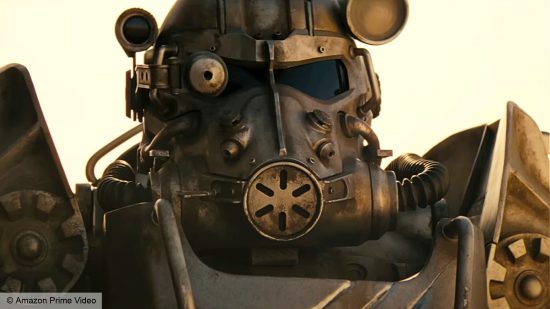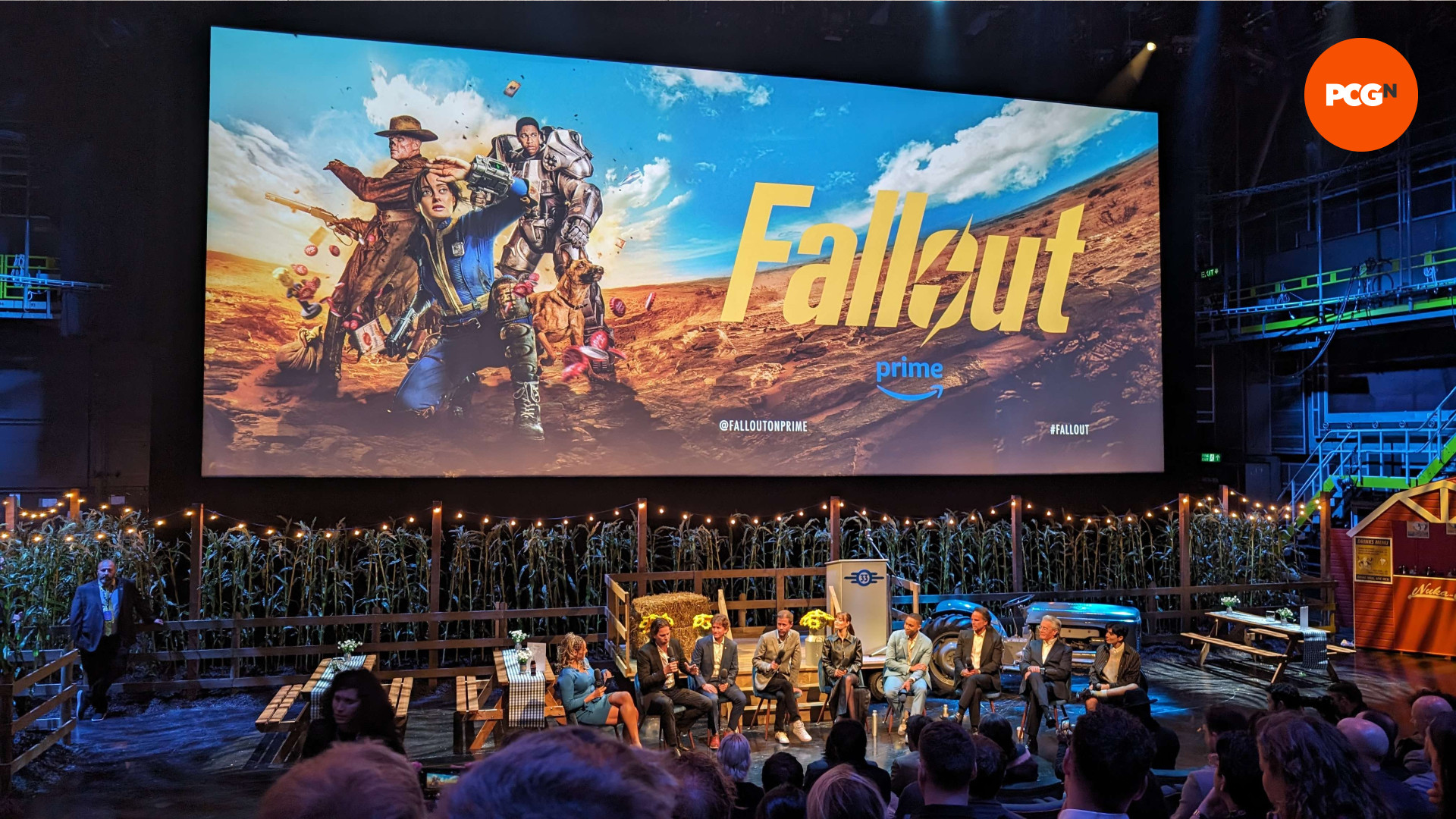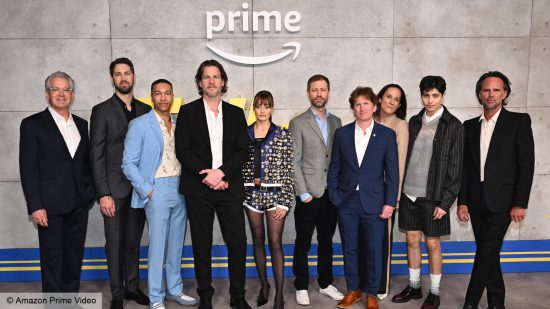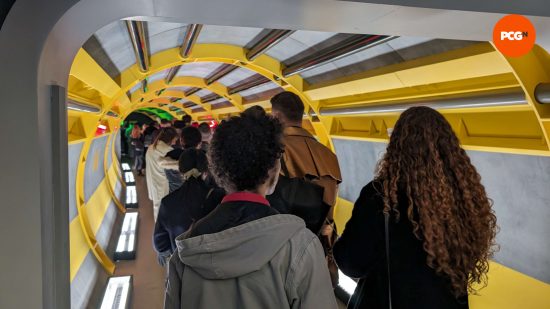The Fallout show on Prime is finally here. Fallout 5 is still a speck in the distance as developer Bethesda Games Studios focuses on post-launch Starfield content and development of The Elder Scrolls 6. However, the retro-futuristic, post-apocalyptic series is back in the spotlight with an all-new tale in the form of an Amazon Prime show from Westworld creators Lisa Joy and Jonathan Nolan. Ahead of its debut, I attended a special press screening for PCGamesN in London, where I watched the first two episodes of the new series. While my initial impression is that it’s far from perfect, I found it to capture the essence of the games remarkably well.
Rather than follow the events of any of the games such as Fallout 4 or the ongoing Fallout 76, the Fallout show brings its own original story to the table, something I’m very much in favor of as a longtime fan of the open-world games. While the likes of The Last of Us have traded well in the retelling of an existing story, which certainly holds value to viewers who might not want to delve into playing a videogame themselves, as someone who has played the Fallout games I’m much more interested in seeing something fresh.
The event itself was a fun novelty – a Vault 33-themed theater, delightfully plasticky hot dogs, and an “emergency lockdown” complete with alarms and panicked workers sealing the doors before rolling the tape on the first two episodes of the new show. We even got treated to a special post-showing Q&A sit down with the leading cast members, Jonathan Nolan, co-writer and producer Graham Wagner (Lisa Joy and fellow writer/producer Geneva Robertson-Dworet were sadly unable to join), and Bethesda executive producer Todd Howard.
But ultimately the series itself is why we were there. As mentioned, the Fallout show tells an original story set in the long-established post-apocalypse – something Howard says he was very eager to do rather than adapting one of the games – and that starts with the first episode, which bears all the hallmarks you’d expect of a new Fallout adventure. We see a little of the Cold War tension being brushed away by partygoers before the bombs fall, we get a glimpse of life inside its massive Vaults, and we get that iconic moment of the Vault door opening as we step out into the irradiated, lawless wasteland.
The show kicks off in the before times; an alternate history atompunk future draped in classic 1950s Americana. Cowboy Cooper Howard (Walton Goggins) is working kids parties to make ends meet, but as the scene draws on the specter of nuclear war creates a lingering unease among the revelers. I won’t spoil the moment itself, inevitable as it is, but I thought it was done brilliantly and outpaces the games’ own attempts to depict this.

We’re then introduced to our trio of leads. Primary protagonist Lucy MacLean (Ella Purnell) is our Vault Dweller; born and raised in the underground complex, she’s capable and knowledgeable, but with an overly optimistic outlook on humanity that seems to serve as the show’s driving force. When she’s forced to leave the safety of the Vault to chase after her father (the always excellent Kyle MacLachlan), will she be able to adapt to the brutal, cutthroat realities of life on the surface; and if she does, will it leave her forever changed for the worse?
Deuteragonist Maximus (Aaron Moten) is a young man rescued from the wasteland by the Brotherhood of Steel, the series’ zealous military organization of soldiers clad in power armor. Assigned as a scribe to the standoffish Knight Titus, Maximus is all too quickly bounced between numerous shades-of-gray moral choices far beyond his station and experience.
Finally, our tritagonist is Goggins in his new form as ‘The Ghoul’ – a name that raises questions in my mind about exactly what role ghouls as a whole will play in the series. Mutated into an impossibly hardy (and remarkably capable) bounty hunter by the radiation, The Ghoul serves as an unknown element of sorts, with his path all-too-quickly thrown across those of both Lucy and Maximus.
All in all, the show’s first episode very much won me over. With Bethesda’s Starfield adopting a remarkably dry tone that left me cold, I was worried we might lose some of the light-hearted charm that has been core to the Fallout series since its inception. At the same time, I was curious whether the show would follow in the footsteps of Fallout 76 in largely tossing out the commentary on the horrors of war and turn the wasteland into a light-hearted nuclear playground.
The good news is that the first episode of the Fallout show strikes the right balance, and on the whole makes a fantastic first impression. All those key moments you want are there, the humor feels natural rather than forced, and the setups for all three characters are strong. In terms of the look, it’s spot-on pretty much across the board and exactly what Fallout fans will want – the Vaults are just how we know them, the outfits are on the money, and every little detail is in place without feeling too wink-and-nudge, from the Pip-Boy and the fashion to that ‘opening the vault door’ moment that we all came to see.
The slight concern is that it peters out at points in episode two – a dramatic fight scene that starts with pace, dark comedy, and the gleefully over-the-top brutality of the game’s notorious ‘bloody mess’ perk starts to languish once the only people left in the fight are plot-essential characters, devolving into overly silly flailing that detracts from the punch of its opening.
Maximus suffers perhaps the most from feeling a bit too much like comic relief, which is interesting given that his story starts as the most intensely straight-laced. There’s some good contemplation of the realities of wearing power armor; the advantages and restrictions provided by a giant, powered exosuit, but that begins to turn into a constant stream of slapstick accidents as episode two rolls on. He’s a character with a lot of potential, and I hope that isn’t squandered too readily in the endless pursuit of comedy bits.
With all that said, the second episode saves itself at the last minute thanks to Dr. Wilzig (Michael Emerson) – a mysterious scientist who seems to hold the key connecting all of our narrative threads. He’s an interesting curiosity throughout, but the closing moments of episode two left me with a burning desire to see where this tale goes next. Howard also suggests the show will give us more of a look into the past than the games, something I didn’t really see here but that I’m eager to find out more about.
The Fallout show mostly nails its tone and setting in line with the games. During the Q&A session, Purnell promises that there are a lot of wild developments to look forward to – “You made a weird, crazy show – in a good way,” she tells Nolan. Hopefully now that all the pieces are in place, it can deliver on its promise and let its characters breathe and grow, because that’s what will truly define how it’s remembered when the dust settles.



